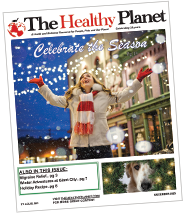Article courtesy of the Clean Air Partnership
The American Lung Association’s 2019 “State of the Air” report is out, and it reveals the number of people exposed to unhealthy air increased to nearly 141.1 million, rising from the 133.9 million in the years covered by the 2018 report (2014-2016). For the third consecutive year, the St. Louis region has escaped being ranked among the top 25 most-polluted cities in the U.S., but the fact that many counties in the St. Louis metro area still had multiple days when the air quality was unhealthy means that there is still much work to be done to protect our local communities from the growing risks to public health resulting from increased levels of ozone and particle pollution.
Far too many cities across the nation saw an increased number of days when ground-level ozone reached unhealthy levels and particle pollution soared to often record-breaking levels in some areas. Altogether, 43.3 percent of the population is exposed to unhealthy levels of air pollution, and while we may not be among the most polluted cities in this year’s ‘State of the Air’ ranking, poor air quality remains a problem that affects everyone in the St. Louis area.
The report reveals that as climate change continues, cleaning up these pollutants will become ever more challenging, ultimately making it harder to protect human health. Increased heat in 2017, the third warmest year on record in the U.S., likely drove this increase in ozone as warmer temperatures stimulate the reactions in the atmosphere that cause ozone to form.
“As we prepare to settle into summer when we’re at greater risk for higher levels of ozone pollution in our region, it’s important to keep in mind children, older adults and those who suffer from lung diseases that make them especially vulnerable to poor air quality,” said Susannah Fuchs, Director, Clean Air for the American Lung Association in Missouri. “While the fight for cleaner air presses on, we encourage area residents to remain steadfast in their efforts to take voluntary steps to reduce emissions because those actions play a critical role in improving air quality conditions and lung health of our region.”
The 2019 air quality forecasting season commenced on May 1st, along with the Clean Air Partnership’s seasonal outreach to educate St. Louis residents on the health effects of air pollution and the steps they can take to keep air quality in healthy ranges. With transportation-related emissions being one of the biggest contributors to air pollution, actions like taking transit, carpooling, vanpooling, telecommuting, avoiding idling our vehicles and combining errands into a single trip can help reduce emissions when poor air quality is forecasted.
For additional information on the health effects of poor air quality and tips for doing your share for cleaner air, visit www.cleanair-stlouis.com, like the Clean Air Partnership on Facebook or follow @gatewaycleanair on Twitter. To access the American Lung Association’s 2019 State of the Air report, visit www.lung.org.


